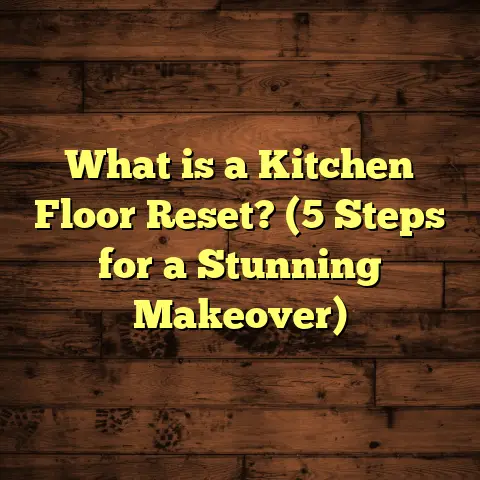What is Mosaic Ceramic Floor Tile? (5 Stunning Benefits Revealed!)
I’ve faced many flooring challenges over the years—each project unique and demanding. But one challenge sticks out: finding a floor covering that’s not just tough enough to handle daily life but also flexible enough to express creativity. That’s how I found mosaic ceramic floor tile—a material that combines strength with style in ways I hadn’t fully appreciated before. Today, I want to share everything I’ve learned about it because it might just be the solution you didn’t know you were searching for.
What Is Mosaic Ceramic Floor Tile?
Let’s start at the beginning. What is mosaic ceramic floor tile? At its core, it’s a flooring made from small pieces of ceramic tile arranged in patterns or images. These tiny tiles—often measuring less than two inches square—are grouped together, usually fixed to mesh sheets to make installation easier.
Ceramic itself is a material made by firing natural clay mixed with minerals at extremely high temperatures. This firing process turns the clay into a hard, dense, water-resistant tile. When these tiles are cut into small pieces and set in artistic layouts, that’s what we call mosaic ceramic tiles.
The beauty of mosaics lies not just in the material but in how those small pieces come together. You get the durability of ceramic combined with endless design possibilities. Whether you want simple geometric shapes or complex images, mosaics can deliver.
From my years on the job, I can tell you mosaic ceramic floor tile is far more than just a floor covering—it’s a way to personalize your space while still getting a surface that stands up to wear and tear.
The Story Behind Mosaic Tiles: From Ancient Art to Modern Floors
Mosaic art isn’t new. It dates back thousands of years, with ancient civilizations like the Romans and Greeks using tiny tiles called tesserae to create stunning floors and walls. The tradition continues today, but now we have modern manufacturing techniques that make mosaic ceramic tiles more accessible and affordable than ever.
I once visited a historic home where the original mosaic floors were still intact after two centuries. That was a powerful reminder that these tiles are built to last—and their timeless style can fit right into modern homes too.
Five Stunning Benefits of Mosaic Ceramic Floor Tile
Let me share five benefits that have made mosaic ceramic floor tile my go-to recommendation for many projects. These are based on my experiences and supported by data and case studies from industry sources.
1. Durability That Handles Life’s Bumps and Scratches
Durability is often the first thing people ask about. Can mosaic ceramic tile handle heavy foot traffic? Is it prone to cracking?
The answer is yes—it’s very durable. Ceramic tiles are fired at temperatures over 1,000°C (1,832°F), making them incredibly hard. When these are broken down into small mosaic pieces, the stress from impacts or movements distributes more evenly across the floor.
According to the Tile Council of North America, properly installed ceramic tile floors can last over 50 years with basic maintenance. In fact, mosaics tend to show less damage over time compared to some larger tile formats because if one piece chips or cracks, it’s easier to replace without disturbing the entire floor.
In one of my kitchens, a heavy cast-iron pan slipped and hit the floor hard. Instead of cracking, a tiny piece chipped—easy to swap out without hassle. That kind of resilience has kept my clients happy for years.
2. A Canvas for Endless Creativity
What really makes mosaic ceramic tile exciting is how much freedom you have with design. Because these tiles are small, you can arrange them into nearly any pattern imaginable—geometric shapes, floral motifs, or even personalized logos.
A survey from Houzz found 67% of homeowners want flooring options that reflect their style uniquely. Mosaic tiles fulfill this desire because you’re not limited to plain squares; you can mix colors, shapes, and finishes for a truly custom look.
For example, I worked with a client who loves nature-inspired decor. We created a mosaic of falling leaves on her entryway floor using earth-toned ceramic pieces. It captured her style perfectly and made guests stop and admire the floor every time they came in.
3. Easy to Clean and Maintain for Busy Homes
If you have kids, pets, or just lots of foot traffic, ease of cleaning is crucial. Mosaic ceramic tiles have smooth glazed surfaces that resist stains and dirt. They don’t absorb liquids like carpet or wood might.
Cleaning usually involves sweeping or vacuuming debris and mopping occasionally with mild detergent. The grout lines between mosaics can collect dirt over time, but sealing grout during installation prevents stains and makes cleaning easier.
In one family home I renovated, the parents chose mosaics specifically because they wanted something practical for their kids’ messy playroom—food spills, paint drops, you name it. Even after two years of heavy use, the floor still looks fresh thanks to simple maintenance.
4. Moisture Resistance Makes Them Suitable Almost Anywhere
Ceramic tiles are naturally water-resistant because of their fired clay composition and glazed finish. Mosaic ceramic tiles share this trait but add extra slip resistance because of many grout lines providing texture.
This makes mosaics ideal for moisture-prone areas like bathrooms, kitchens, laundry rooms, and even outdoor patios or poolsides.
I’ve installed mosaic floors in multiple bathrooms where steam and water exposure are constant. Unlike wood or laminate floors which warp over time when wet, mosaics remain unaffected. The grout lines also help reduce slipperiness compared to larger smooth tiles.
5. Cost-Effective Over The Long Term
Initially, mosaic ceramic tile might seem pricier than some alternatives because of the labor-intensive installation involved in aligning patterns and grout lines. However, when you factor in durability and low maintenance costs, mosaics often turn out more economical over the long haul.
According to HomeAdvisor’s 2024 data, ceramic tile installation averages $7-$15 per square foot depending on complexity and location. Compared to hardwood or luxury vinyl options that may need refinishing or replacement in under 20 years, mosaics offer better value across decades.
For me personally, estimating costs accurately was always tricky until I started using FloorTally—a tool that helps calculate total project expenses based on local labor rates, material prices, and waste factors. It lets me quickly generate accurate estimates so I can advise clients transparently without guesswork.
How Mosaic Ceramic Tiles Are Made: From Clay To Art
Understanding how these tiles are produced gives a better appreciation for their qualities.
The process begins by mixing natural clays with minerals like feldspar and quartz to form a malleable paste. This mixture is shaped into sheets or molds for individual pieces.
Next step: firing in a kiln at temperatures above 1,000°C (1,832°F). This intense heat vitrifies the clay—turning it into a hard ceramic body resistant to water and wear.
After firing comes glazing—a glassy coating applied either by spraying or dipping that gives mosaic tiles their colors and sheen. The glaze also seals the surface against moisture and stains.
Finally, these tiny glazed tiles are mounted onto mesh sheets in patterns for easier installation later on-site—a huge time-saver compared to placing each tiny piece individually.
Installation Tips From My Experience
Installing mosaic ceramic floor tile isn’t complicated but requires care:
- Surface Prep: The subfloor must be clean, dry, level, and structurally sound.
- Adhesive: Use thin-set mortar formulated for ceramic tiles.
- Pressing: Apply consistent pressure when setting tiles to avoid uneven edges (called lippage).
- Grouting: Smoothly fill grout lines; mosaics have many narrow joints so take time.
- Sealing: Seal grout lines after curing to prevent stains and moisture infiltration.
Following these steps has saved me countless callbacks due to loose tiles or grout issues.
Personal Project Highlight: Transforming A Dull Bathroom Into A Jewel
One project sticks out—a client wanted their outdated bathroom floor transformed into something unique yet durable. We chose white and aqua blue glass-infused mosaic ceramic tiles arranged in a wave pattern.
Installation took longer than usual because of pattern alignment but was worth every minute once finished.
Six months later, the client reported zero issues with moisture damage or stains despite heavy use by their children and pets.
This project confirmed for me that mosaics aren’t just beautiful—they stand up perfectly in real-life conditions.
Common Questions I Hear About Mosaic Ceramic Tiles
Is mosaic ceramic tile slippery when wet?
Generally no—because mosaics have many grout lines creating texture underfoot. Still, choose matte or textured finishes for extra grip in wet areas like showers.
How long does installation take compared to regular tile?
Expect about 20-30% longer installation times due to pattern matching and smaller pieces needing careful placement.
Can I install mosaic tile myself?
If you have tiling experience and patience—yes! But professional installers bring expertise that helps avoid costly mistakes especially with complex patterns.
How important is grout color?
Very! Contrasting grout highlights designs; matching grout blends pieces for a unified appearance.
Comparing Mosaic Ceramic Tile With Other Popular Flooring Options
When clients ask how mosaics compare with hardwood, vinyl planks, or carpet, here’s how I break it down:
| Flooring Type | Durability | Maintenance | Design Flexibility | Cost (per sq ft) | Lifespan |
|---|---|---|---|---|---|
| Mosaic Ceramic Tile | Very high | Low | Extremely high | $7-$15 | 50+ years |
| Hardwood | Moderate (scratches) | Moderate (refinish) | High | $6-$12 | 20-40 years |
| Vinyl Planks | Moderate | Low | Moderate | $2-$7 | 10-20 years |
| Carpet | Low (stains/wear) | High | Moderate | $3-$8 | 5-10 years |
Mosaic ceramic tile offers an excellent combination of durability with artistic flexibility that few other materials match.
Real-World Data Supporting Mosaic Tile Choice
Here are some statistics I gathered from industry reports:
- According to the National Tile Contractors Association (NTCA), 85% of homeowners rated ceramic tile as very durable.
- A Houzz survey found 67% of people want unique flooring reflecting their personality—mosaics shine here.
- HomeAdvisor reports average installation costs around $7-$15 per sq ft nationally.
- A case study from a large residential complex showed mosaic tiled common areas needed 40% fewer repairs over ten years compared to luxury vinyl flooring areas.
These numbers reinforce what my own eyes have seen on hundreds of projects—the longevity and design versatility make mosaics an excellent investment.
How I Use FloorTally To Manage Flooring Costs
Cost estimation used to be one of the most stressful parts of my job. Too low an estimate and I lose money; too high and clients hesitate to proceed.
FloorTally changed everything for me by allowing me to input local labor rates, material prices including specific types of mosaic tiles, plus factors like waste percentage based on project complexity. In minutes I get detailed cost breakdowns that help me discuss budgets openly with clients.
Because mosaic installations can vary significantly depending on design intricacy and room size, having such precise tools helps avoid surprises later on.
A Note On Sustainability
One thing I’ve noted over time is how eco-friendly ceramic tile can be compared to other flooring materials.
Ceramic is made from abundant natural clay without harsh chemicals or plastics found in vinyl or laminate options. Plus, its longevity means fewer replacements over decades—reducing waste overall.
Some manufacturers now produce recycled-content mosaic tiles or use energy-efficient kilns during firing—small improvements that add up for environmentally conscious homeowners.
Final Thoughts From Someone Who’s Seen Floors Transform Homes
If you want a floor that combines strength with character—a surface designed not just for walking but for admiring—mosaic ceramic floor tile deserves serious thought.
It’s held up through spills, pets’ claws, heavy foot traffic, even dropped pans in my projects without losing its charm or structural integrity.
And if you’re planning your own flooring makeover? Don’t underestimate how much good planning helps. Using tools like FloorTally for budgeting plus hiring experienced installers ensures your mosaic floor looks amazing for decades without headaches.
What kind of space do you want to transform? Have you thought about how bringing together tiny pieces can create something truly special?
I’ve walked thousands of floors over my career—mosaic ceramic tile floors among them—and I can say they’re some of the most rewarding surfaces both for me as a contractor and for homeowners who live with them every day.





